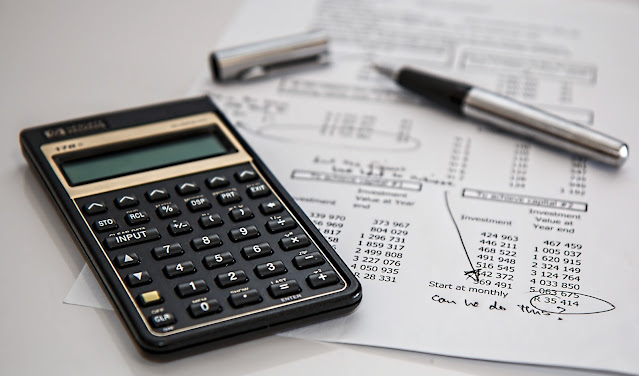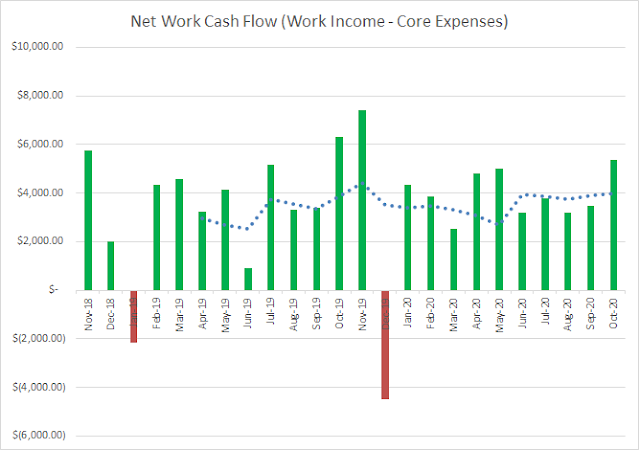Budget Check & Cash Flow Update - October 2020
 |
| Budget Check & Cash Flow Update - October 2020 |
The saying goes that cash is king. While that's true, a more accurate saying when it comes to finances is that CASH FLOW is king. Whether you're retired, still working or just starting out the only way you can improve your financial house is to have positive cash flow.
If you're in the accumulation phase then that positive cash flow allows you to save and invest to build up your future cash flow. If you're already retired, or FIREd, then congratulations because I'm sure your cash flow is well above what you need.
When it comes to personal finance it's rather simple: income - expenses = savings and savings x investing x time = financial independence. There's obviously two main levers there and while we'd all like to increase our income, many times reducing expenses is some of the low hanging fruit that you can go after to increase your savings.
Budget Check
Total income for October was a whopping $8,647.52 due to a 3rd paycheck with my bi-weekly pay schedule. That's in line with the TTM average which now sits at $8,137.83. There's some noise in those numbers since it includes all income sources throughout the year, but it's a good rough guide of the average monthly total income. The bulk of my income, ~92%, came from my day job, le sigh; although that should come as no surprise since we're still in the accumulation phase. Dividends were the next largest income source at 5.0% with interest, writing and other (cash back...) accounting for 0.2%, 1.9% and 1.2%, respectively.
Total expenses for October came in at $4,050.55 which is well below the TTM average that now sits at $4,526.68. That does include the $1,500 of extra debt payments as well as the increased expenses from our trip in early October.
Looking at just core expenses, October's total came to $2,550.55 which was a big increase from September but still below the TTM average of $3,123.86. Looking at just the last 7 months when I switched into my new job role the average monthly core expenses are $2,272.46.
For the month we ended up with a net positive cash flow of $4,596.97 when looking at all income sources. Based on just work income, but including all expenses, the net positive cash flow came to $3,878.58.
Our savings rate from all income sources came to 53% while our savings rate from work income alone was 49%.
*A few notes about the cash flow check in. All income is only income that I receive and does not include my wife's income likewise for the expenses. We've found it's easiest for us to just keep separate accounts since I'm gone most of the time for work. Also, pre-tax withholding for the 401k (I currently withhold 7% in order to get the full 5% employer match) and the ESPP through my employer (4% post tax withholding) are not included in the above savings amount.
Net Work Cash Flow
While my net cash flow above includes all income and all expenses, I wanted to get a more granular look at the cash flow that is available each month. So I started calculating my Net Work Cash Flow which is calculated as post-tax income only from my work and core expenses. Think of it more like a free cash flow for a business.
The above might be the true cash flow each month; however, it's not really representative of our "free cash flow" each month. The idea is that all other income sources outside of work income are already going directly into savings or investing or in the case of dividends remaining in the brokerage account. On the expense side the majority of our expenses fall into the core side and most of the other expenses are extra debt payments rather than further discretionary spending.
I believe this gives a better idea of our "free" cash flow each month that can/will be used for debt reduction, saving and investing.
My net work cash flow continued to be quite strong in September with $5,378.58. That's higher than my 6-month average, which I expect will continue to drift lower barring any significant changes, that currently sits at $4,003.29. Considering that includes only the time since I started my new job role which came with a bit of reduction in pay, but much better work/life balance, I'm ecstatic to see those numbers over an extended period of time and will be more than happy to see those levels continue moving forward.
Non-Work Cash Flow
Passive income for October totaled $457.32 and covered 17.9% of core expenses. Meanwhile, non-work income totaled $718.39 and covered 28.2% of core expenses for October.
Conclusion
I now have 7 full months in my new job role and as such believe that I have a good idea of what a "normal" month will look like. There will obviously be fluctuations month to month due to changes in both income and expenses. Considering all of the benefits of the new job role I'm more than happy to see that we should have somewhere between $3-4k to work with each month for debt reduction or investing.
I think we'll continue with the plan that we've been using the last few months which is allocate ~$1,500 towards debt reduction and the remainder going towards the investment account. I might reconsider allocating a bit more towards the debt reduction since we're in the home stretch. If we stick with the plan we've been following we're looking at roughly a March or April payoff, whereas if we increase the allocation to 2:1 debt versus investing the payoff would move to February to March payoff. There's not a significant difference either way, but I'll be a very happy camper when that debt is gone.
Make sure you sign up to receive new posts to your email so you don't miss anything. And be sure to follow me on Twitter @JC_PIP to get up to the minute news of purchases for my portfolio or if you prefer Pinterest or Facebook I'm on there too.
If you were in our situation would you funnel all cash flow towards debt reduction or splitting the difference like we're planning?



Comments
Post a Comment